|
|

|
|
Author
|
Topic: NASA's Juno to look into Jupiter's atmosphere
|
Robert Pearlman
Editor Posts: 54408
From: Houston, TX
Registered: Nov 1999
|
 posted 07-01-2017 10:42 AM
posted 07-01-2017 10:42 AM
   
NASA release NASA's Juno Spacecraft to Fly Over Jupiter's Great Red Spot July 10Just days after celebrating its first anniversary in Jupiter orbit, NASA's Juno spacecraft will fly directly over Jupiter's Great Red Spot, the gas giant's iconic, 10,000-mile-wide (16,000-kilometer-wide) storm. This will be humanity's first up-close and personal view of the gigantic feature — a storm monitored since 1830 and possibly existing for more than 350 years. "Jupiter's mysterious Great Red Spot is probably the best-known feature of Jupiter," said Scott Bolton, principal investigator of Juno from the Southwest Research Institute in San Antonio. "This monumental storm has raged on the solar system's biggest planet for centuries. Now, Juno and her cloud-penetrating science instruments will dive in to see how deep the roots of this storm go, and help us understand how this giant storm works and what makes it so special." The data collection of the Great Red Spot is part of Juno's sixth science flyby over Jupiter's mysterious cloud tops. Perijove (the point at which an orbit comes closest to Jupiter's center) will be on Monday, July 10, at 6:55 p.m. PDT (9:55 p.m. EDT). At the time of perijove, Juno will be about 2,200 miles (3,500 kilometers) above the planet's cloud tops. Eleven minutes and 33 seconds later, Juno will have covered another 24,713 miles (39,771 kilometers) and will be directly above the coiling crimson cloud tops of Jupiter's Great Red Spot. The spacecraft will pass about 5,600 miles (9,000 kilometers) above the Giant Red Spot clouds. All eight of the spacecraft's instruments as well as its imager, JunoCam, will be on during the flyby. On July 4 at 7:30 p.m. PDT (10:30 p.m. EDT), Juno will have logged exactly one year in Jupiter orbit. At the time, the spacecraft will have chalked up about 71 million miles (114.5 million kilometers) in orbit around the giant planet. "The success of science collection at Jupiter is a testament to the dedication, creativity and technical abilities of the NASA-Juno team," said Rick Nybakken, project manager for Juno from NASA's Jet Propulsion Laboratory in Pasadena, California. "Each new orbit brings us closer to the heart of Jupiter's radiation belt, but so far the spacecraft has weathered the storm of electrons surrounding Jupiter better than we could have ever imagined." Juno launched on Aug. 5, 2011, from Cape Canaveral, Florida. During its mission of exploration, Juno soars low over the planet's cloud tops — as close as about 2,100 miles (3,400 kilometers). During these flybys, Juno is probing beneath the obscuring cloud cover of Jupiter and studying its auroras to learn more about the planet's origins, structure, atmosphere and magnetosphere. Early science results from NASA's Juno mission portray the largest planet in our solar system as a turbulent world, with an intriguingly complex interior structure, energetic polar aurora, and huge polar cyclones. |
Robert Pearlman
Editor Posts: 54408
From: Houston, TX
Registered: Nov 1999
|
 posted 07-11-2017 04:35 PM
posted 07-11-2017 04:35 PM
   
NASA release NASA's Juno Spacecraft Completes Flyby Over Jupiter's Great Red SpotNASA's Juno mission completed a close flyby of Jupiter and its Great Red Spot on July 10, during its sixth science orbit. All of Juno's science instruments and the spacecraft's JunoCam were operating during the flyby, collecting data that are now being returned to Earth. Juno's next close flyby of Jupiter will occur on Sept. 1. Raw images from the spacecraft's latest flyby will be posted in coming days. "For generations people from all over the world and all walks of life have marveled over the Great Red Spot," said Scott Bolton, principal investigator of Juno from the Southwest Research Institute in San Antonio. "Now we are finally going to see what this storm looks like up close and personal." The Great Red Spot is a 10,000-mile-wide (16,000-kilometer-wide) storm that has been monitored since 1830 and has possibly existed for more than 350 years. In modern times, the Great Red Spot has appeared to be shrinking. Juno reached perijove (the point at which an orbit comes closest to Jupiter's center) on July 10 at 6:55 p.m. PDT (9:55 p.m. EDT). At the time of perijove, Juno was about 2,200 miles (3,500 kilometers) above the planet's cloud tops. Eleven minutes and 33 seconds later, Juno had covered another 24,713 miles (39,771 kilometers), and was passing directly above the coiling crimson cloud tops of the Great Red Spot. The spacecraft passed about 5,600 miles (9,000 kilometers) above the clouds of this iconic feature. On July 4 at 7:30 p.m. PDT (10:30 p.m. EDT), Juno logged exactly one year in Jupiter orbit, marking 71 million miles (114.5 million kilometers) of travel around the giant planet. Juno launched on Aug. 5, 2011, from Cape Canaveral, Florida. During its mission of exploration, Juno soars low over the planet's cloud tops -- as close as about 2,100 miles (3,400 kilometers). During these flybys, Juno is probing beneath the obscuring cloud cover of Jupiter and studying its auroras to learn more about the planet's origins, structure, atmosphere and magnetosphere. Early science results from NASA's Juno mission portray the largest planet in our solar system as a turbulent world, with an intriguingly complex interior structure, energetic polar aurora, and huge polar cyclones. |
Robert Pearlman
Editor Posts: 54408
From: Houston, TX
Registered: Nov 1999
|
 posted 07-12-2017 07:29 PM
posted 07-12-2017 07:29 PM
   
NASA release NASA's Juno Spacecraft Spots Jupiter's Great Red SpotImages of Jupiter's Great Red Spot reveal a tangle of dark, veinous clouds weaving their way through a massive crimson oval. The JunoCam imager aboard NASA's Juno mission snapped pics of the most iconic feature of the solar system's largest planetary inhabitant during its Monday (July 10) flyby. The images of the Great Red Spot were downlinked from the spacecraft's memory on Tuesday and placed on the mission's JunoCam website Wednesday morning. 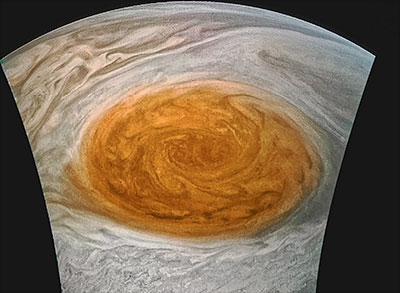 Above: This enhanced-color image of Jupiter's Great Red Spot was created by citizen scientist Jason Major using data from the JunoCam imager on NASA's Juno spacecraft. (NASA/JPL-Caltech/SwRI/MSSS/Jason Major) "For hundreds of years scientists have been observing, wondering and theorizing about Jupiter's Great Red Spot," said Scott Bolton, Juno principal investigator from the Southwest Research Institute in San Antonio. "Now we have the best pictures ever of this iconic storm. It will take us some time to analyze all the data from not only JunoCam, but Juno's eight science instruments, to shed some new light on the past, present and future of the Great Red Spot." As planned by the Juno team, citizen scientists took the raw images of the flyby from the JunoCam site and processed them, providing a higher level of detail than available in their raw form. The citizen-scientist images, as well as the raw images they used for image processing, can be found here. "I have been following the Juno mission since it launched," said Jason Major, a JunoCam citizen scientist and a graphic designer from Warwick, Rhode Island. "It is always exciting to see these new raw images of Jupiter as they arrive. But it is even more thrilling to take the raw images and turn them into something that people can appreciate. That is what I live for." 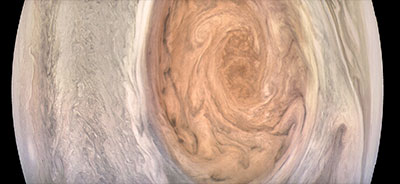 Above: This enhanced-color image of Jupiter's Great Red Spot was created by citizen scientist Kevin Gill using data from the JunoCam imager on NASA's Juno spacecraft. (NASA/JPL-Caltech/SwRI/MSSS/Kevin Gill) Measuring in at 10,159 miles (16,350 kilometers) in width (as of April 3, 2017) Jupiter's Great Red Spot is 1.3 times as wide as Earth. The storm has been monitored since 1830 and has possibly existed for more than 350 years. In modern times, the Great Red Spot has appeared to be shrinking. All of Juno's science instruments and the spacecraft's JunoCam were operating during the flyby, collecting data that are now being returned to Earth. Juno's next close flyby of Jupiter will occur on Sept. 1. Juno reached perijove (the point at which an orbit comes closest to Jupiter's center) on July 10 at 6:55 p.m. PDT (9:55 p.m. EDT). At the time of perijove, Juno was about 2,200 miles (3,500 kilometers) above the planet's cloud tops. Eleven minutes and 33 seconds later, Juno had covered another 24,713 miles (39,771 kilometers), and was passing directly above the coiling, crimson cloud tops of the Great Red Spot. The spacecraft passed about 5,600 miles (9,000 kilometers) above the clouds of this iconic feature. 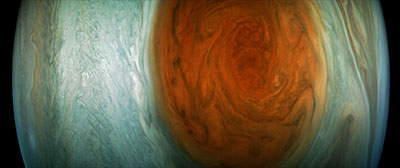 Above: This enhanced-color image of Jupiter's Great Red Spot was created by citizen scientist Gerald Eichstädt using data from the JunoCam imager on NASA's Juno spacecraft. (NASA/JPL-Caltech/SwRI/MSSS/Gerald Eichstädt) Juno launched on Aug. 5, 2011, from Cape Canaveral, Florida. During its mission of exploration, Juno soars low over the planet's cloud tops — as close as about 2,100 miles (3,400 kilometers). During these flybys, Juno is probing beneath the obscuring cloud cover of Jupiter and studying its auroras to learn more about the planet's origins, structure, atmosphere and magnetosphere. Early science results from NASA's Juno mission portray the largest planet in our solar system as a turbulent world, with an intriguingly complex interior structure, energetic polar aurora, and huge polar cyclones. "These highly-anticipated images of Jupiter's Great Red Spot are the 'perfect storm' of art and science. With data from Voyager, Galileo, New Horizons, Hubble and now Juno, we have a better understanding of the composition and evolution of this iconic feature," said Jim Green, NASA's director of planetary science. "We are pleased to share the beauty and excitement of space science with everyone." |
Robert Pearlman
Editor Posts: 54408
From: Houston, TX
Registered: Nov 1999
|
 posted 02-08-2018 10:23 AM
posted 02-08-2018 10:23 AM
   
NASA release Juno Completes Tenth Science Orbit of JupiterJuno accomplished a close flyby over Jupiter’s churning atmosphere on Wednesday, Feb. 7, successfully completing its tenth science orbit. The closest approach was at 6:36 a.m. PST (9:36 a.m. PST) Earth-received time. At the time of perijove (the point in Juno's orbit when it is closest to the planet's center), the spacecraft will be about 2,100 miles (3,500 kilometers) above the planet's cloud tops. This flyby was a gravity science orientation pass. During orbits that highlight gravity experiments, Juno is in an Earth-pointed orientation that allows both the X-band and Ka-Band transmitter to downlink data in real-time to one of the antennas of NASA's Deep Space Network in Goldstone, California. All of Juno’s science instruments and the spacecraft’s JunoCam were in operation during the flyby, collecting data that is now being returned to Earth. 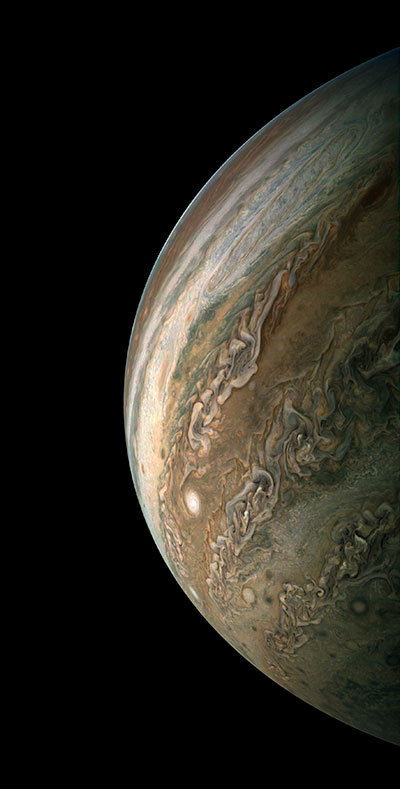 Above: This image of Jupiter’s southern hemisphere was captured by NASA’s Juno spacecraft as it performed a close flyby of the gas giant planet on Dec. 16. (NASA/JPL-Caltech/SwRI/MSSS/Gerald Eichstädt) |
Robert Pearlman
Editor Posts: 54408
From: Houston, TX
Registered: Nov 1999
|
 posted 06-06-2018 07:00 PM
posted 06-06-2018 07:00 PM
   
NASA release Juno Solves 39-Year Old Mystery of Jupiter LightningEver since NASA's Voyager 1 spacecraft flew past Jupiter in March, 1979, scientists have wondered about the origin of Jupiter's lightning. That encounter confirmed the existence of Jovian lightning, which had been theorized for centuries. But when the venerable explorer hurtled by, the data showed that the lightning-associated radio signals didn't match the details of the radio signals produced by lightning here at Earth. 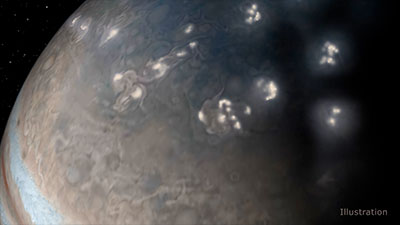 Above: This artist's concept of lightning distribution in Jupiter's northern hemisphere incorporates a JunoCam image with artistic embellishments. Data from NASA's Juno mission indicates that most of the lightning activity on Jupiter is near its poles. (NASA/JPL-Caltech/SwRI/JunoCam) In a new paper published in Nature today, scientists from NASA's Juno mission describe the ways in which lightning on Jupiter is actually analogous to Earth's lightning. Although, in some ways, the two types of lightning are polar opposites. "No matter what planet you're on, lightning bolts act like radio transmitters — sending out radio waves when they flash across a sky," said Shannon Brown of NASA's Jet Propulsion Laboratory in Pasadena, California, a Juno scientist and lead author of the paper. "But until Juno, all the lightning signals recorded by spacecraft [Voyagers 1 and 2, Galileo, Cassini] were limited to either visual detections or from the kilohertz range of the radio spectrum, despite a search for signals in the megahertz range. Many theories were offered up to explain it, but no one theory could ever get traction as the answer." Enter Juno, which has been orbiting Jupiter since July 4, 2016. Among its suite of highly sensitive instruments is the Microwave Radiometer Instrument (MWR), which records emissions from the gas giant across a wide spectrum of frequencies. "In the data from our first eight flybys, Juno's MWR detected 377 lightning discharges," said Brown. "They were recorded in the megahertz as well as gigahertz range, which is what you can find with terrestrial lightning emissions. We think the reason we are the only ones who can see it is because Juno is flying closer to the lighting than ever before, and we are searching at a radio frequency that passes easily through Jupiter's ionosphere." While the revelation showed how Jupiter lightning is similar to Earth's, the new paper also notes that where these lightning bolts flash on each planet is actually quite different. "Jupiter lightning distribution is inside out relative to Earth," said Brown. "There is a lot of activity near Jupiter's poles but none near the equator. You can ask anybody who lives in the tropics — this doesn't hold true for our planet." Why do lightning bolts congregate near the equator on Earth and near the poles on Jupiter? Follow the heat. Earth's derives the vast majority of its heat externally from solar radiation, courtesy of our Sun. Because our equator bears the brunt of this sunshine, warm moist air rises (through convection) more freely there, which fuels towering thunderstorms that produce lightning. Jupiter's orbit is five times farther from the Sun than Earth's orbit, which means that the giant planet receives 25 times less sunlight than Earth. But even though Jupiter's atmosphere derives the majority of its heat from within the planet itself, this doesn't render the Sun's rays irrelevant. They do provide some warmth, heating up Jupiter's equator more than the poles — just as they heat up Earth. Scientists believe that this heating at Jupiter's equator is just enough to create stability in the upper atmosphere, inhibiting the rise of warm air from within. The poles, which do not have this upper-level warmth and therefore no atmospheric stability, allow warm gases from Jupiter's interior to rise, driving convection and therefore creating the ingredients for lightning. "These findings could help to improve our understanding of the composition, circulation and energy flows on Jupiter," said Brown. But another question looms, she said. "Even though we see lightning near both poles, why is it mostly recorded at Jupiter's north pole?" In a second Juno lightning paper published today in Nature Astronomy, Ivana Kolmašová of the Czech Academy of Sciences, Prague, and colleagues, present the largest database of lightning-generated low-frequency radio emissions around Jupiter (whistlers) to date. The data set of more than 1,600 signals, collected by Juno's Waves instrument, is almost 10 times the number recorded by Voyager 1. Juno detected peak rates of four lightning strikes per second (similar to the rates observed in thunderstorms on Earth) which is six times higher than the peak values detected by Voyager 1. "These discoveries could only happen with Juno," said Scott Bolton, principal investigator of Juno from the Southwest Research Institute, San Antonio. "Our unique orbit allows our spacecraft to fly closer to Jupiter than any other spacecraft in history, so the signal strength of what the planet is radiating out is a thousand times stronger. Also, our microwave and plasma wave instruments are state-of-the-art, allowing us to pick out even weak lightning signals from the cacophony of radio emissions from Jupiter. " NASA's Juno spacecraft will make its 13th science flyby over Jupiter's mysterious cloud tops on July 16. |
Robert Pearlman
Editor Posts: 54408
From: Houston, TX
Registered: Nov 1999
|
 posted 06-06-2018 07:06 PM
posted 06-06-2018 07:06 PM
   
NASA release NASA Re-plans Juno's Jupiter MissionNASA has approved an update to Juno's science operations until July 2021. This provides for an additional 41 months in orbit around Jupiter and will enable Juno to achieve its primary science objectives.Juno is in 53-day orbits rather than 14-day orbits as initially planned because of a concern about valves on the spacecraft's fuel system. This longer orbit means that it will take more time to collect the needed science data. An independent panel of experts confirmed in April that Juno is on track to achieve its science objectives and is already returning spectacular results.The Juno spacecraft and all instruments are healthy and operating nominally. NASA has now funded Juno through FY 2022. The end of prime operations is now expected in July 2021, with data analysis and mission close-out activities continuing into 2022. "With these funds, not only can the Juno team continue to answer long-standing questions about Jupiter that first fueled this exciting mission, but they'll also investigate new scientific puzzles motivated by their discoveries thus far," said Thomas Zurbuchen, associate administrator for NASA's Science Mission Directorate in Washington. "With every additional orbit, both scientists and citizen scientists will help unveil new surprises about this distant world." "This is great news for planetary exploration as well as for the Juno team," said Scott Bolton, principal investigator of Juno, from the Southwest Research Institute in San Antonio. "These updated plans for Juno will allow it to complete its primary science goals. As a bonus, the larger orbits allow us to further explore the far reaches of the Jovian magnetosphere — the region of space dominated by Jupiter's magnetic field — including the far magnetotail, the southern magnetosphere, and the magnetospheric boundary region called the magnetopause. We have also found Jupiter's radiation environment in this orbit to be less extreme than expected, which has been beneficial to not only our spacecraft, but our instruments and the continued quality of science data collected." Juno will make its 13th science flyby over Jupiter's mysterious cloud tops on July 16. |
Robert Pearlman
Editor Posts: 54408
From: Houston, TX
Registered: Nov 1999
|
 posted 10-24-2018 08:33 AM
posted 10-24-2018 08:33 AM
   
NASA release NASA's Juno Mission Detects Jupiter Wave TrainsMassive structures of moving air that appear like waves in Jupiter's atmosphere were first detected by NASA's Voyager missions during their flybys of the gas-giant world in 1979. The JunoCam camera aboard NASA's Juno mission to Jupiter has also imaged the atmosphere. JunoCam data has detected atmospheric wave trains, towering atmospheric structures that trail one after the other as they roam the planet, with most concentrated near Jupiter's equator. 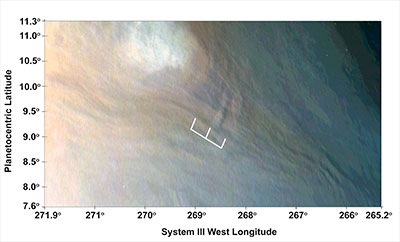 Above: Three waves can be seen in this excerpt of a JunoCam image taken on Feb. 2, 2017, during Juno's fourth flyby of Jupiter. The region imaged in this picture is part of the visibly dark band just north of Jupiter's equator known as the North Equatorial Belt. (NASA/JPL-Caltech/SwRI/MSSS/JunoCam) The JunoCam imager has resolved smaller distances between individual wave crests in these trains than ever seen before. This research provides valuable information on both the dynamics of Jupiter's atmosphere and its structure in the regions underneath the waves. "JunoCam has counted more distinct wave trains than any other spacecraft mission since Voyager," said Glenn Orton, a Juno scientist from NASA's Jet Propulsion Laboratory in Pasadena, California. "The trains, which consist of as few as two waves and as many as several dozen, can have a distance between crests as small as about 40 miles (65 kilometers) and as large as about 760 miles (1,200 kilometers). The shadow of the wave structure in one image allowed us to estimate the height of one wave to be about 6 miles (10 kilometers) high." Most of the waves are seen in elongated wave trains, spread out in an east-west direction, with wave crests that are perpendicular to the orientation of the train. Other fronts in similar wave trains tilt significantly with respect to the orientation of the wave train, and still other wave trains follow slanted or meandering paths. "The waves can appear close to other Jovian atmospheric features, near vortices or along flow lines, and others exhibit no relationship with anything nearby," said Orton. "Some wave trains appear as if they are converging, and others appear to be overlapping, possibly at two different atmospheric levels. In one case, wave fronts appear to be radiating outward from the center of a cyclone." Although analysis is ongoing, most waves are expected to be atmospheric gravity waves - up-and-down ripples that form in the atmosphere above something that disturbs air flow, such as a thunderstorm updraft, disruptions of flow around other features, or from some other disturbance that JunoCam does not detect. The JunoCam instrument is uniquely qualified to make such a discovery. JunoCam is a color, visible-light camera which offers a wide-angle field of view designed to capture remarkable pictures of Jupiter's poles and cloud tops. As Juno's eyes, it helps provide context for the spacecraft's other instruments. JunoCam was included on the spacecraft primarily for public engagement purposes, although its images also are helpful to the science team. |
Robert Pearlman
Editor Posts: 54408
From: Houston, TX
Registered: Nov 1999
|
 posted 12-12-2018 03:33 PM
posted 12-12-2018 03:33 PM
   
NASA release NASA's Juno Mission Halfway to Jupiter ScienceOn Dec. 21, at 8:49:48 a.m. PST (11:49:48 a.m. EST) NASA's Juno spacecraft will be 3,140 miles (5,053 kilometers) above Jupiter's cloud tops and hurtling by at a healthy clip of 128,802 mph (207,287 kilometers per hour). This will be the 16th science pass of the gas giant and will mark the solar-powered spacecraft's halfway point in data collection during its prime mission. 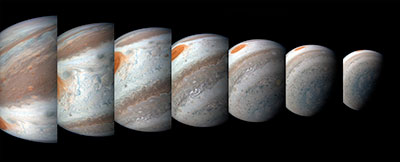 Above: A south tropical disturbance has just passed Jupiter's iconic Great Red Spot, and is captured stealing threads of orange haze from the Great Red Spot in this series of color-enhanced images from NASA's Juno spacecraft. (NASA/JPL-Caltech/SwRI/MSSS/Gerald Eichstadt/Sean Doran) Juno is in a highly-elliptical 53-day orbit around Jupiter. Each orbit includes a close passage over the planet's cloud deck, where it flies a ground track that extends from Jupiter's north pole to its south pole. "With our 16th science flyby, we will have complete global coverage of Jupiter, albeit at coarse resolution, with polar passes separated by 22.5 degrees of longitude," said Jack Connerney, Juno deputy principal investigator from the Space Research Corporation in Annapolis, Maryland. "Over the second half of our prime mission - science flybys 17 through 32 - we will split the difference, flying exactly halfway between each previous orbit. This will provide coverage of the planet every 11.25 degrees of longitude, providing a more detailed picture of what makes the whole of Jupiter tick." Launched on Aug. 5, 2011, from Cape Canaveral, Florida, the spacecraft entered orbit around Jupiter on July 4, 2016. Its science collection began in earnest on the Aug. 27, 2016, flyby. During these flybys, Juno's suite of sensitive science instruments probes beneath the planet's obscuring cloud cover and studies Jupiter's auroras to learn more about the planet's origins, interior structure, atmosphere and magnetosphere. "We have already rewritten the textbooks on how Jupiter's atmosphere works, and on the complexity and asymmetry of its magnetic field," said Scott Bolton, principal investigator of Juno, from the Southwest Research Institute in San Antonio. "The second half should provide the detail that we can use to refine our understanding of the depth of Jupiter's zonal winds, the generation of its magnetic field, and the structure and evolution of its interior." Two instruments aboard Juno, the Stellar Reference Unit and JunoCam, have proven to be useful not only for their intended purposes, but also for science data collection. The Stellar Reference Unit (SRU) was designed to collect engineering data used for navigation and attitude determination, so the scientists were pleased to find that it has scientific uses as well. "We always knew the SRU had a vital engineering job to do for Juno," said Heidi Becker, Juno's radiation monitoring investigation lead at NASA's Jet Propulsion Laboratory in Pasadena, California. "But after making scientific discoveries in Jupiter's radiation belts and taking a first-of-its-kind image of Jupiter's ring, we realized the added value of the data. There is serious scientific interest in what the SRU can tell us about Jupiter." The JunoCam imager was conceived as an outreach instrument to bring the excitement and beauty of Jupiter exploration to the public. "While originally envisioned solely as an outreach instrument to help tell the Juno story, JunoCam has become much more than that," said Candy Hansen, Juno co-investigator at the Planetary Science Institute in Tucson, Arizona. "Our time-lapse sequences of images over the poles allow us to study the dynamics of Jupiter's unique circumpolar cyclones and to image high-altitude hazes. We are also using JunoCam to study the structure of the Great Red Spot and its interaction with its surroundings." The SRU and JunoCam teams both now have several peer-reviewed science papers -either published or in the works - to their credit. |
Robert Pearlman
Editor Posts: 54408
From: Houston, TX
Registered: Nov 1999
|
 posted 10-02-2019 11:48 AM
posted 10-02-2019 11:48 AM
   
NASA release NASA's Juno Prepares to Jump Jupiter's ShadowLast night, NASA's Juno mission to Jupiter successfully executed a 10.5-hour propulsive maneuver — extraordinarily long by mission standards. The goal of the burn, as it's known, will keep the solar-powered spacecraft out of what would have been a mission-ending shadow cast by Jupiter on the spacecraft during its next close flyby of the planet on Nov. 3, 2019. Juno began the maneuver yesterday, on Sept. 30, at 7:46 p.m. EDT (4:46 p.m. PDT) and completed it early on Oct. 1. Using the spacecraft's reaction-control thrusters, the propulsive maneuver lasted five times longer than any previous use of that system. It changed Juno's orbital velocity by 126 mph (203 kph) and consumed about 160 pounds (73 kilograms) of fuel. Without this maneuver, Juno would have spent 12 hours in transit across Jupiter's shadow - more than enough time to drain the spacecraft's batteries. Without power, and with spacecraft temperatures plummeting, Juno would likely succumb to the cold and be unable to awaken upon exit. "With the success of this burn, we are on track to jump the shadow on Nov. 3," said Scott Bolton, Juno principal investigator at the Southwest Research Institute in San Antonio. "Jumping over the shadow was an amazingly creative solution to what seemed like a fatal geometry. Eclipses are generally not friends of solar-powered spacecraft. Now instead of worrying about freezing to death, I am looking forward to the next science discovery that Jupiter has in store for Juno." Juno has been navigating in deep space since 2011. It entered an initial 53-day orbit around Jupiter on July 4, 2016. Originally, the mission planned to reduce the size of its orbit a few months later to decrease the period between science flybys of the gas giant to every 14 days. But the project team recommended to NASA to forgo the main engine burn due to concerns about the spacecraft's fuel delivery system. Juno's 53-day orbit provides all the science as originally planned; it just takes longer to do so. The spacecraft's longer life at Jupiter is what led to the need to avoid the gas giant's shadow. "Pre-launch mission planning did not anticipate a lengthy eclipse that would plunge our solar-powered spacecraft into darkness," said Ed Hirst, Juno project manager at NASA's Jet Propulsion Laboratory in Pasadena, California. "That we could plan and execute the necessary maneuver while operating in Jupiter's orbit is a testament to the ingenuity and skill of our team, along with the extraordinary capability and versatility of our spacecraft." |
Robert Pearlman
Editor Posts: 54408
From: Houston, TX
Registered: Nov 1999
|
 posted 07-23-2020 11:18 AM
posted 07-23-2020 11:18 AM
   
NASA release NASA Juno Takes First Images of Jovian Moon Ganymede's North PoleOn its way inbound for a Dec. 26, 2019, flyby of Jupiter, NASA's Juno spacecraft flew in the proximity of the north pole of the ninth-largest object in the solar system, the moon Ganymede. The infrared imagery collected by the spacecraft's Jovian Infrared Auroral Mapper (JIRAM) instrument provides the first infrared mapping of the massive moon's northern frontier.  Above: These images the JIRAM instrument aboard NASA's Juno spacecraft took on Dec. 26, 2019, provide the first infrared mapping of Ganymede's northern frontier. Frozen water molecules detected at both poles have no appreciable order to their arrangement and a different infrared signature than ice at the equator. (NASA/JPL-Caltech/SwRI/ASI/INAF/JIRAM) The only moon in the solar system that is larger than the planet Mercury, Ganymede consists primarily of water ice. Its composition contains fundamental clues for understanding the evolution of the 79 Jovian moons from the time of their formation to today. Ganymede is also the only moon in the solar system with its own magnetic field. On Earth, the magnetic field provides a pathway for plasma (charged particles from the Sun) to enter our atmosphere and create aurora. As Ganymede has no atmosphere to impede their progress, the surface at its poles is constantly being bombarded by plasma from Jupiter's gigantic magnetosphere. The bombardment has a dramatic effect on Ganymede's ice. "The JIRAM data show the ice at and surrounding Ganymede's north pole has been modified by the precipitation of plasma," said Alessandro Mura, a Juno co-investigator at the National Institute for Astrophysics in Rome. "It is a phenomenon that we have been able to learn about for the first time with Juno because we are able to see the north pole in its entirety." 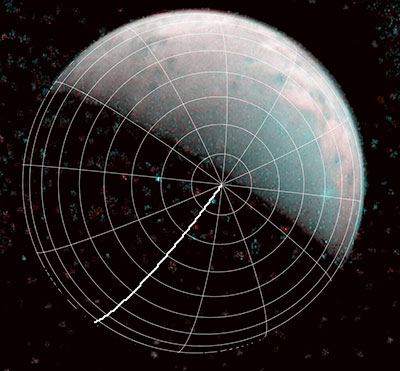 Above: The north pole of Ganymede can be seen in center of this annotated image taken by the JIRAM infrared imager aboard NASA's Juno spacecraft on Dec. 26, 2019. The thick line is 0-degrees longitude. (NASA/JPL-Caltech/SwRI/ASI/INAF/JIRAM) The ice near both poles of the moon is amorphous. This is because charged particles follow the moon's magnetic field lines to the poles, where they impact, wreaking havoc on the ice there, preventing it from having an ordered (or crystalline) structure. In fact, frozen water molecules detected at both poles have no appreciable order to their arrangement, and the amorphous ice has a different infrared signature than the crystalline ice found at Ganymede's equator. "These data are another example of the great science Juno is capable of when observing the moons of Jupiter," said Giuseppe Sindoni, program manager of the JIRAM instrument for the Italian Space Agency. JIRAM was designed to capture the infrared light emerging from deep inside Jupiter, probing the weather layer down to 30 to 45 miles (50 to 70 kilometers) below Jupiter's cloud tops. But the instrument can also be used to study the moons Io, Europa, Ganymede, and Callisto (also known collectively as the Galilean moons for their discoverer, Galileo). Knowing the top of Ganymede would be within view of Juno on Dec. 26 flyby of Jupiter, the mission team programmed the spacecraft to turn so instruments like JIRAM could see Ganymede's surface. At the time surrounding its closest approach of Ganymede – at about 62,000 miles (100,000 kilometers) – JIRAM collected 300 infrared images of the surface, with a spatial resolution of 14 miles (23 kilometers) per pixel. |
Robert Pearlman
Editor Posts: 54408
From: Houston, TX
Registered: Nov 1999
|
 posted 06-08-2021 05:22 PM
posted 06-08-2021 05:22 PM
   
NASA release See the First Images NASA's Juno Took As It Sailed by GanymedeThe first two images from NASA Juno's June 7, 2021, flyby of Jupiter's giant moon Ganymede have been received on Earth. The photos – one from the Jupiter orbiter's JunoCam imager and the other from its Stellar Reference Unit star camera – show the surface in remarkable detail, including craters, clearly distinct dark and bright terrain, and long structural features possibly linked to tectonic faults. 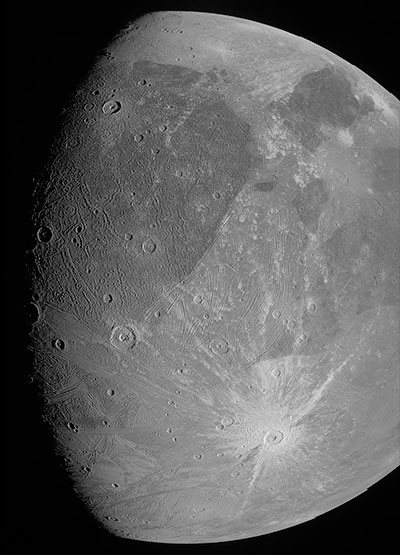 Above: This image of Ganymede was obtained by the JunoCam imager during Juno's June 7, 2021, flyby of the icy moon. (NASA/JPL-Caltech/SwRI) "This is the closest any spacecraft has come to this mammoth moon in a generation," said Juno Principal Investigator Scott Bolton of the Southwest Research Institute in San Antonio. "We are going to take our time before we draw any scientific conclusions, but until then we can simply marvel at this celestial wonder – the only moon in our solar system bigger than the planet Mercury." Using its green filter, the spacecraft's JunoCam visible-light imager captured almost an entire side of the water-ice-encrusted moon. Later, when versions of the same image come down incorporating the camera's red and blue filters, imaging experts will be able to provide a color portrait of Ganymede. Image resolution is about 0.6 miles (1 kilometer) per pixel. In addition, Juno's Stellar Reference Unit, a navigation camera that keeps the spacecraft on course, provided a black-and-white picture of Ganymede's dark side (the side opposite the Sun) bathed in dim light scattered off Jupiter. Image resolution is between 0.37 to 0.56 miles (600 to 900 meters) per pixel. "The conditions in which we collected the dark side image of Ganymede were ideal for a low-light camera like our Stellar Reference Unit," said Heidi Becker, Juno's radiation monitoring lead at JPL. "So this is a different part of the surface than seen by JunoCam in direct sunlight. It will be fun to see what the two teams can piece together." 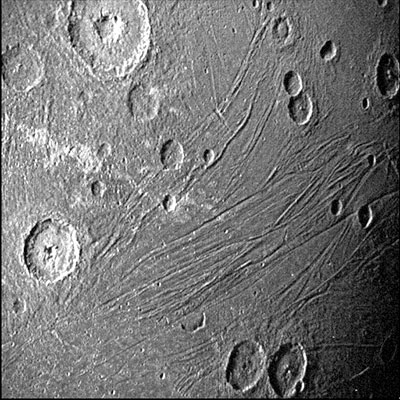 Above: This image of the dark side of Ganymede was obtained by Juno's Stellar Reference Unit navigation camera during its June 7, 2021, flyby of the moon. (NASA/JPL-Caltech/SwRI) The spacecraft will send more images from its Ganymede flyby in the coming days, with JunoCam's raw images being made available here. The solar-powered spacecraft's encounter with the Jovian moon is expected to yield insights into its composition, ionosphere, magnetosphere, and ice shell while also providing measurements of the radiation environment that will benefit future missions to the Jovian system. |
SpaceAholic
Member Posts: 5449
From: Sierra Vista, Arizona
Registered: Nov 1999
|
 posted 07-06-2021 02:25 PM
posted 07-06-2021 02:25 PM
   
NASA release (March 9, 2021) Serendipitous Juno Detections Shatter Ideas About Origin of Zodiacal LightData from the NASA spacecraft's journey to Jupiter suggests that Mars may be shedding dust into interplanetary space. Look up to the night sky just before dawn, or after dusk, and you might see a faint column of light extending up from the horizon. That luminous glow is the zodiacal light, or sunlight reflected toward Earth by a cloud of tiny dust particles orbiting the Sun. Astronomers have long thought that the dust is brought into the inner solar system by a few of the asteroid and comet families that venture in from afar. But now, a team of Juno scientists argues that Mars may be the culprit. They published their finding in a March 9 paper in the Journal of Geophysical Research: Planets. An instrument aboard the Juno spacecraft serendipitously detected dust particles slamming into the spacecraft during its journey from Earth to Jupiter. The impacts provided important clues to the origin and orbital evolution of the dust, resolving some mysterious variations of the zodiacal light. Though their discovery has big implications, the scientists who spent years studying cosmic debris did not set out to do so. "I never thought we'd be looking for interplanetary dust," said John Leif Jørgensen, a professor at the Technical University of Denmark. Jørgensen designed the four star trackers that are part of Juno's magnetometer investigation. These onboard cameras snap photos of the sky every quarter of a second to determine Juno's orientation in space by recognizing star patterns in its images – an engineering task essential to the magnetometer's accuracy. But Jørgensen hoped his cameras might also catch sight of an undiscovered asteroid. So he programmed one camera to report things that appeared in multiple consecutive images but weren't in the catalog of known celestial objects. He didn't expect to see much: Nearly all objects in the sky are accounted for in the star catalog. So when the camera started beaming down thousands of images of unidentifiable objects – streaks appearing then mysteriously disappearing – Jørgensen and his colleagues were baffled. "We were looking at the images and saying, 'What could this be?'" he said. Jørgensen and his team considered many plausible and some implausible causes. There was the unnerving possibility that the star camera had caught a leaking fuel tank on Juno. "We thought, 'Something is really wrong,'" Jørgensen said. "The images looked like someone was shaking a dusty tablecloth out their window." It wasn't until the researchers calculated the apparent size and velocity of the objects in the images that they finally realized something: Dust grains had smashed into Juno at about 10,000 miles (or 16,000 kilometers) per hour, chipping off submillimeter pieces of spacecraft. "Even though we're talking about objects with only a tiny bit of mass, they pack a mean punch," said Jack Connerney, Juno's magnetometer investigation lead and the mission's deputy principal investigator, who's based at NASA's Goddard Space Flight Center in Greenbelt, Maryland. As it turned out, the spray of debris was coming from Juno's expansive solar panels – the biggest and most sensitive unintended dust detector ever built. "Each piece of debris we tracked records the impact of an interplanetary dust particle, allowing us to compile a distribution of dust along Juno's path," Connerney said. Juno launched in 2011. After a deep-space maneuver in the asteroid belt in 2012, it returned to the inner solar system for an Earth gravity assist in 2013, which catapulted the spacecraft towards Jupiter. Connerney and Jørgensen noticed that the majority of dust impacts were recorded between Earth and the asteroid belt, with gaps in the distribution related to the influence of Jupiter's gravity. According to the scientists, this was a radical revelation. Before now, scientists have been unable to measure the distribution of these dust particles in space. Dedicated dust detectors have had limited collection areas and thus limited sensitivity to a sparse population of dust. They mostly count the more abundant and much smaller dust particles from interstellar space. In comparison, Juno's expansive solar panels have 1,000 times more collection area than most dust detectors. Juno scientists determined that the dust cloud ends at Earth because Earth's gravity sucks up all the dust that gets near it. "That's the dust we see as zodiacal light," Jørgensen said. As for the outer edge, around 2 astronomical units (AU) from the Sun (1 AU is the distance between Earth and the Sun), it ends just beyond Mars. At that point, the scientists report, the influence of Jupiter's gravity acts as a barrier, preventing dust particles from crossing from the inner solar system into deep space. This same phenomenon, known as orbital resonance, also works the other way, where it blocks dust originating in deep space from passing into the inner solar system. The profound influence of the gravity barrier indicates that the dust particles are in a nearly circular orbit around the Sun, Jørgensen said. "And the only object we know of in almost circular orbit around 2 AU is Mars, so the natural thought is that Mars is a source of this dust," he said. "The distribution of dust that we measure better be consistent with the variation of zodiacal light that has been observed," Connerney said. The researchers developed a computer model to predict the light reflected by the dust cloud, dispersed by gravitational interaction with Jupiter that scatters the dust into a thicker disk. The scattering depends only on two quantities: the dust inclination to the ecliptic and its orbital eccentricity. When the researchers plugged in the orbital elements of Mars, the distribution accurately predicted the telltale signature of the variation of zodiacal light near the ecliptic. "That is, in my view, a confirmation that we know exactly how these particles are orbiting in our solar system," Connerney said, "and where they originate." While there is good evidence now that Mars, the dustiest planet we know of, is the source of the zodiacal light, Jørgensen and his colleagues cannot yet explain how the dust could have escaped the grip of Martian gravity. They hope other scientists will help them. In the meantime, the researchers note that finding the true distribution and density of dust particles in the solar system will help engineers design spacecraft materials that can better withstand dust impacts. Knowing the precise distribution of dust may also guide the design of flight paths for future spacecraft in order to avoid the highest concentration of particles. Tiny particles traveling at such high velocities can gouge up to 1,000 times their mass from a spacecraft. Juno's solar arrays escaped harm because the solar cells are well protected against impact on the back – or dark – side of the array by the support structure. |
Robert Pearlman
Editor Posts: 54408
From: Houston, TX
Registered: Nov 1999
|
 posted 10-28-2021 02:01 PM
posted 10-28-2021 02:01 PM
   
NASA release NASA's Juno: Science Results Offer First 3D View of Jupiter AtmosphereNew findings from NASA's Juno probe orbiting Jupiter provide a fuller picture of how the planet's distinctive and colorful atmospheric features offer clues about the unseen processes below its clouds. The results highlight the inner workings of the belts and zones of clouds encircling Jupiter, as well as its polar cyclones and even the Great Red Spot. 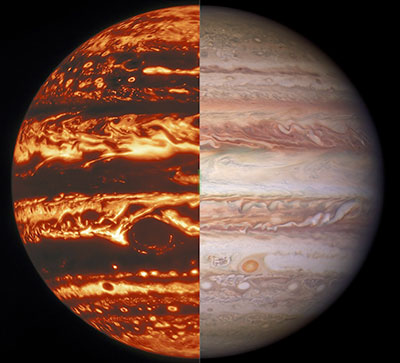 Above: This illustration combines an image of Jupiter from the JunoCam instrument aboard NASA’s Juno spacecraft with a composite image of Earth to depict the size and depth of Jupiter’s Great Red Spot. (NASA/JPL-Caltech/SwRI/MSSS; JunoCam Image processing by Kevin M. Gill (CC BY); Earth Image: NASA) Researchers published several papers on Juno's atmospheric discoveries today in the journal Science and the Journal of Geophysical Research: Planets. Additional papers appeared in two recent issues of Geophysical Research Letters. "These new observations from Juno open up a treasure chest of new information about Jupiter's enigmatic observable features," said Lori Glaze, director of NASA's Planetary Science Division at the agency's headquarters in Washington. "Each paper sheds light on different aspects of the planet's atmospheric processes – a wonderful example of how our internationally-diverse science teams strengthen understanding of our solar system." Juno entered Jupiter's orbit in 2016. During each of the spacecraft's 37 passes of the planet to date, a specialized suite of instruments has peered below its turbulent cloud deck. "Previously, Juno surprised us with hints that phenomena in Jupiter's atmosphere went deeper than expected," said Scott Bolton, principal investigator of Juno from the Southwest Research Institute in San Antonio and lead author of the Journal Science paper on the depth of Jupiter's vortices. "Now, we're starting to put all these individual pieces together and getting our first real understanding of how Jupiter's beautiful and violent atmosphere works – in 3D." 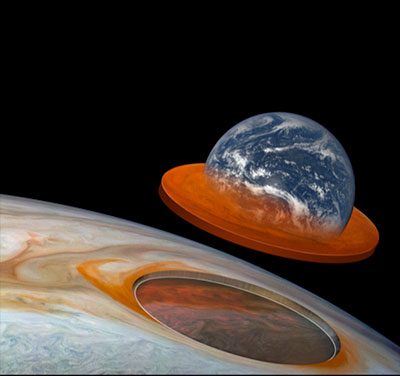 Above: This illustration combines an image of Jupiter from the JunoCam instrument aboard NASA’s Juno spacecraft with a composite image of Earth to depict the size and depth of Jupiter’s Great Red Spot. (JunoCam Image data: NASA/JPL-Caltech/SwRI/MSSS; JunoCam Image processing by Kevin M. Gill (CC BY); Earth Image: NASA) Juno's microwave radiometer (MWR) allows mission scientists to peer beneath Jupiter's cloud tops and probe the structure of its numerous vortex storms. The most famous of these storms is the iconic anticyclone known as the Great Red Spot. Wider than Earth, this crimson vortex has intrigued scientists since its discovery almost two centuries ago. The new results show that the cyclones are warmer on top, with lower atmospheric densities, while they are colder at the bottom, with higher densities. Anticyclones, which rotate in the opposite direction, are colder at the top but warmer at the bottom. The findings also indicate these storms are far taller than expected, with some extending 60 miles (100 kilometers) below the cloud tops and others, including the Great Red Spot, extending over 200 miles (350 kilometers). This surprise discovery demonstrates that the vortices cover regions beyond those where water condenses and clouds form, below the depth where sunlight warms the atmosphere. The height and size of the Great Red Spot means the concentration of atmospheric mass within the storm potentially could be detectable by instruments studying Jupiter's gravity field. Two close Juno flybys over Jupiter's most famous spot provided the opportunity to search for the storm's gravity signature and complement the MWR results on its depth. With Juno traveling low over Jupiter's cloud deck at about 130,000 mph (209,000 kph) Juno scientists were able to measure velocity changes as small 0.01 millimeter per second using a NASA's Deep Space Network tracking antenna, from a distance of more than 400 million miles (650 million kilometers). This enabled the team to constrain the depth of the Great Red Spot to about 300 miles (500 kilometers) below the cloud tops. "The precision required to get the Great Red Spot's gravity during the July 2019 flyby is staggering," said Marzia Parisi, a Juno scientist from NASA's Jet Propulsion Laboratory in Southern California and lead author of a paper in the Journal Science on gravity overflights of the Great Red Spot. "Being able to complement MWR's finding on the depth gives us great confidence that future gravity experiments at Jupiter will yield equally intriguing results." Belts and Zones In addition to cyclones and anticyclones, Jupiter is known for its distinctive belts and zones – white and reddish bands of clouds that wrap around the planet. Strong east-west winds moving in opposite directions separate the bands. Juno previously discovered that these winds, or jet streams, reach depths of about 2,000 miles (roughly 3,200 kilometers). Researchers are still trying to solve the mystery of how the jet streams form. Data collected by Juno's MWR during multiple passes reveal one possible clue: that the atmosphere's ammonia gas travels up and down in remarkable alignment with the observed jet streams. "By following the ammonia, we found circulation cells in both the north and south hemispheres that are similar in nature to 'Ferrel cells,' which control much of our climate here on Earth", said Keren Duer, a graduate student from the Weizmann Institute of Science in Israel and lead author of the Journal Science paper on Ferrel-like cells on Jupiter. "While Earth has one Ferrel cell per hemisphere, Jupiter has eight – each at least 30 times larger." Juno's MWR data also shows that the belts and zones undergo a transition around 40 miles (65 kilometers) beneath Jupiter's water clouds. At shallow depths, Jupiter's belts are brighter in microwave light than the neighboring zones. But at deeper levels, below the water clouds, the opposite is true – which reveals a similarity to our oceans. "We are calling this level the 'Jovicline' in analogy to a transitional layer seen in Earth's oceans, known as the thermocline – where seawater transitions sharply from being relative warm to relative cold," said Leigh Fletcher, a Juno participating scientist from the University of Leicester in the United Kingdom and lead author of the paper in the Journal of Geophysical Research: Planets highlighting Juno's microwave observations of Jupiter's temperate belts and zones. Polar Cyclones Juno previously discovered polygonal arrangements of giant cyclonic storms at both of Jupiter's poles – eight arranged in an octagonal pattern in the north and five arranged in a pentagonal pattern in the south. Now, five years later, mission scientists using observations by the spacecraft's Jovian Infrared Auroral Mapper (JIRAM) have determined these atmospheric phenomena are extremely resilient, remaining in the same location. "Jupiter's cyclones affect each other's motion, causing them to oscillate about an equilibrium position," said Alessandro Mura, a Juno co-investigator at the National Institute for Astrophysics in Rome and lead author of a recent paper in Geophysical Research Letters on oscillations and stability in Jupiter's polar cyclones. "The behavior of these slow oscillations suggests that they have deep roots." JIRAM data also indicates that, like hurricanes on Earth, these cyclones want to move poleward, but cyclones located at the center of each pole push them back. This balance explains where the cyclones reside and the different numbers at each pole. |
Robert Pearlman
Editor Posts: 54408
From: Houston, TX
Registered: Nov 1999
|
 posted 09-29-2022 02:40 PM
posted 09-29-2022 02:40 PM
   
NASA release NASA's Juno Shares First Image From Flyby of Jupiter's Moon EuropaThe first picture NASA's Juno spacecraft took as it flew by Jupiter's ice-encrusted moon Europa has arrived on Earth. Revealing surface features in a region near the moon's equator called Annwn Regio, the image was captured during the solar-powered spacecraft's closest approach, on Thursday, Sept. 29, at 2:36 a.m. PDT (5:36 a.m. EDT), at a distance of about 219 miles (352 kilometers).  Above: The complex, ice-covered surface of Jupiter's moon Europa was captured by NASA's Juno spacecraft during a flyby on Sept. 29, 2022. At closest approach, the spacecraft came within a distance of about 219 miles (352 kilometers). (NASA/JPL-Caltech/SWRI/MSSS) This is only the third close pass in history below 310 miles (500 kilometers) altitude and the closest look any spacecraft has provided at Europa since Jan. 3, 2000, when NASA's Galileo came within 218 miles (351 kilometers) of the surface. Europa is the sixth-largest moon in the solar system, slightly smaller than Earth's moon. Scientists think a salty ocean lies below a miles-thick ice shell, sparking questions about potential conditions capable of supporting life underneath Europa's surface. This segment of the first image of Europa taken during this flyby by the spacecraft's JunoCam (a public-engagement camera) zooms in on a swath of Europa's surface north of the equator. Due to the enhanced contrast between light and shadow seen along the terminator (the nightside boundary), rugged terrain features are easily seen, including tall shadow-casting blocks, while bright and dark ridges and troughs curve across the surface. The oblong pit near the terminator might be a degraded impact crater. With this additional data about Europa's geology, Juno's observations will benefit future missions to the Jovian moon, including the agency's Europa Clipper. Set to launch in 2024, Europa Clipper will study the moon's atmosphere, surface, and interior, with its main science goal being to determine whether there are places below Europa's surface that could support life. As exciting as Juno's data will be, the spacecraft had only a two-hour window to collect it, racing past the moon with a relative velocity of about 14.7 miles per second (23.6 kilometers per second). "It's very early in the process, but by all indications Juno's flyby of Europa was a great success," said Scott Bolton, Juno principal investigator from Southwest Research Institute in San Antonio. "This first picture is just a glimpse of the remarkable new science to come from Juno's entire suite of instruments and sensors that acquired data as we skimmed over the moon's icy crust." During the flyby, the mission collected what will be some of the highest-resolution images of the moon (0.6 miles, or 1 kilometer, per pixel) and obtained valuable data on Europa's ice shell structure, interior, surface composition, and ionosphere, in addition to the moon's interaction with Jupiter's magnetosphere. "The science team will be comparing the full set of images obtained by Juno with images from previous missions, looking to see if Europa's surface features have changed over the past two decades," said Candy Hansen, a Juno co-investigator who leads planning for the camera at the Planetary Science Institute in Tucson, Arizona. "The JunoCam images will fill in the current geologic map, replacing existing low-resolution coverage of the area." Juno's close-up views and data from its Microwave Radiometer (MWR) instrument will provide new details on how the structure of Europa's ice varies beneath its crust. Scientists can use all this information to generate new insights into the moon, including data in the search for regions where liquid water may exist in shallow subsurface pockets. Building on Juno's observations and previous missions such as Voyager 2 and Galileo, NASA's Europa Clipper mission, slated to arrive at Europa in 2030, will study the moon's atmosphere, surface, and interior – with a goal to investigate habitability and better understand its global subsurface ocean, the thickness of its ice crust, and search for possible plumes that may be venting subsurface water into space. The close flyby modified Juno's trajectory, reducing the time it takes to orbit Jupiter from 43 to 38 days. The flyby also marks the second encounter with a Galilean moon during Juno's extended mission. The mission explored Ganymede in June 2021 and is scheduled to make close flybys of Io, the most volcanic body in the solar system, in 2023 and 2024. |
Robert Pearlman
Editor Posts: 54408
From: Houston, TX
Registered: Nov 1999
|
 posted 01-28-2023 11:50 AM
posted 01-28-2023 11:50 AM
   
NASA release NASA's Juno Team Assessing Camera After 48th Flyby of JupiterEngineering data is being evaluated to determine why the majority of images taken by the solar-powered orbiter's JunoCam were not acquired. The JunoCam imager aboard NASA's Juno spacecraft did not acquire all planned images during the orbiter's most recent flyby of Jupiter on Jan. 22. Data received from the spacecraft indicates that the camera experienced an issue similar to one that occurred on its previous close pass of the gas giant last month, when the team saw an anomalous temperature rise after the camera was powered on in preparation for the flyby. However, on this new occasion the issue persisted for a longer period of time (23 hours compared to 36 minutes during the December close pass), leaving the first 214 JunoCam images planned for the flyby unusable. As with the previous occurrence, once the anomaly that caused the temperature rise cleared, the camera returned to normal operation and the remaining 44 images were of good quality and usable. The mission team is evaluating JunoCam engineering data acquired during the two recent flybys – the 47th and 48th of the mission – and is investigating the root cause of the anomaly and mitigation strategies. JunoCam will remain powered on for the time being and the camera continues to operate in its nominal state. JunoCam is a color, visible-light camera designed to capture pictures of Jupiter's cloud tops. It was included on the spacecraft specifically for purposes of public engagement but has proven to be important for science investigations also. The camera was originally designed to operate in Jupiter's high-energy particle environment for at least seven orbits but has survived far longer. The spacecraft will make its 49th pass of Jupiter on March 1. |
Robert Pearlman
Editor Posts: 54408
From: Houston, TX
Registered: Nov 1999
|
 posted 04-10-2025 08:20 AM
posted 04-10-2025 08:20 AM
   
NASA release NASA's Juno Back to Normal Operations After Entering Safe ModeThe spacecraft was making its 71st close approach to Jupiter when it unexpectedly entered into a precautionary status. Data received from NASA's Juno mission indicates the solar-powered spacecraft went into safe mode twice on April 4 while the spacecraft was flying by Jupiter. Safe mode is a precautionary status that a spacecraft enters when it detects an anomaly. Nonessential functions are suspended, and the spacecraft focuses on essential tasks like communication and power management. Upon entering safe mode, Juno's science instruments were powered down, as designed, for the remainder of the flyby. The mission operations team has reestablished high-rate data transmission with Juno, and the spacecraft is currently conducting flight software diagnostics.The team will work in the ensuing days to transmit the engineering and science data collected before and after the safe-mode events to Earth. Juno first entered safe mode at 5:17 a.m. EDT, about an hour before its 71st close passage of Jupiter — called perijove. It went into safe mode again 45 minutes after perijove. During both safe-mode events, the spacecraft performed exactly as designed, rebooting its computer, turning off nonessential functions, and pointing its antenna toward Earth for communication. Of all the planets in our solar system, Jupiter is home to the most hostile environment, with the radiation belts closest to the planet being the most intense. Early indications suggest the two Perijove 71 safe-mode events occurred as the spacecraft flew through these belts. To block high-energy particles from impacting sensitive electronics and mitigate the harmful effects of the radiation, Juno features a titanium radiation vault. Including the Perijove 71 events, Juno has unexpectedly entered spacecraft-induced safe mode four times since arriving at Jupiter in July 2016: first, in 2016 during its second orbit, then in 2022 during its 39th orbit. In all four cases, the spacecraft performed as expected and recovered full capability. Juno's next perijove will occur on May 7 and include a flyby of the Jovian moon Io at a distance of about 55,300 miles (89,000 kilometers). | |
Contact Us | The Source for Space History & Artifacts
Copyright 1999-2025 collectSPACE. All rights reserved.

Ultimate Bulletin Board 5.47a
|
|

|
 advertisement advertisement

|

























